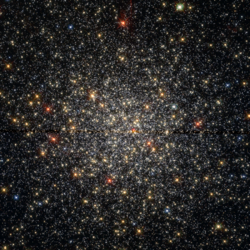Astronomy:NGC 5927
From HandWiki
Short description: Globular cluster in the constellation Lupus
| NGC 5927 | |
|---|---|
 The globular cluster NGC 5927 imaged by the Hubble Space Telescope | |
| Observation data (J2000 epoch) | |
| Class | VIII |
| Constellation | Lupus |
| Right ascension | 15h 28m 00.69s[1] |
| Declination | −50° 40′ 22.9″[1] |
| Distance | 25.1 kly (7.7 kpc)[1] |
| Apparent magnitude (V) | 8.86[1] |
| Physical characteristics | |
| Radius | 6.0' x 6.0'[2] |
| Metallicity | [math]\displaystyle{ \begin{smallmatrix}\left[\ce{Fe}/\ce{H}\right]\end{smallmatrix} }[/math] = -0.49[3] dex |
| Other designations | GCl 35, GCRV 5278 E, VDBH 173[1] |
NGC 5927 is a globular cluster in the constellation Lupus. NGC 5927 has a diameter of about 12 arcminutes and an apparent magnitude of +8.86. Its Shapley–Sawyer Concentration Class is VIII,[2] and it contains stars of magnitude 15 and dimmer.
The globular cluster was discovered by the astronomer James Dunlop in 1826 and was also observed in 1834 by John Herschel.[4]
NGC 5927 is relatively metal-rich for a globular cluster, and may have multiple generations of stars.[5]
References
- ↑ 1.0 1.1 1.2 1.3 1.4 "NGC 5927". SIMBAD. Centre de données astronomiques de Strasbourg. http://simbad.u-strasbg.fr/simbad/sim-basic?Ident=NGC+5927.
- ↑ 2.0 2.1 "NGC 5927". http://spider.seds.org/spider/MWGC/n5927.html.
- ↑ "A Galactic Globular Clusters Database: NGC 5927". http://gclusters.altervista.org/cluster_4.php?ggc=NGC+5927.
- ↑ "New General Catalog Objects: NGC 5900 - 5949". https://cseligman.com/text/atlas/ngc59.htm#5927.
- ↑ d'Orazi, V. et al. (2018), "On the Chemical Abundances of Miras in Clusters: V1 in the Metal-rich Globular NGC 5927", The Astrophysical Journal 855 (1): L9, doi:10.3847/2041-8213/aab100, Bibcode: 2018ApJ...855L...9D
External links
 |

